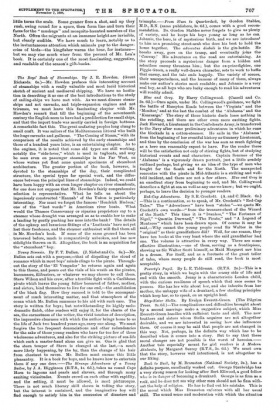THE ROMANCE OF BIRD LIFE.* - THE romance of birds probably
begins the moment they are fledged—and who can doubt that they feel something of the wonder of their first migration?—but we know for certain that it becomes a fact, as is the case with other bipeds, when the days of courtship arrive. Even the nightingale is a mere croaker when the nesting season is over, and the note of the cuckoo, which gives such magical associations to our English landscape, is only a love-call. As far as the bird is concerned, its resonant music is an accident; it might just as well be the challenge of the bull moose or the bray of the donkey. It is audible, and that is enough. Then comes the romance, to us, of the defence of hearth and home. We can appreciate this. Every haying season sees many a partridge cut asunder on her neat by the ruthless mower, and the frantic lapwing almost knocks the hat off your head. Mr. Lea quotes the story of a martin's courage when a thunderstorm had partially wrecked her nest. The two unfledged youngsters were put back after a piece of board had been nailed under the nest, which was mended with clay, and some cotton-wool inserted. The martin continued to sit till the repairs were finished, when she flew round chirping cheerfully. This romance takes a sterner form occa- sionally. The present writer saw a martins' nest in which the first brood had been reared and temporarily deserted become the scene of a domestic tragedy. The martins returned and evicted, after a fierce struggle, the intruding family, the unfledged corpses of the young sparrows pointing the moral on the path below.
The games and antics of birds, especially in courting-time, are often ridiculous enough. The peewit makes the circuit of the fallow field, somersaulting in a fashion that Would excite the envy of a " tumbler " pigeon if be ever wandered far enough from the loft to see it. There is a breed of birdi in India that willy-nilly must tumble, and continue to do so till they have to be picked up and fanned. But the past-master in the art of playing the fool is the parson bird of New Zealand. It is quite possible that some birds in captivity may play more than in a state of freedom. One wishes they would continue to invent games. Storks play with children, and probably the young of most birds and beasts can play. Cranes play ball with a pebble, tossing it in the air and catching it, and a raven has been seen to play with a stick as a dog does with a stone or a ball. As most people think, quite wrongly, that the ancient Egyptians took life seriously, they may be shocked to hear that the sacred ibis is fond of playing practical jokes on the flamingoes. Again, the bower birds and the gardener birds make charming little pleasaunces, which they not only plan and decorate, but play about in, just as children do in a " grown-up " garden.
The flight and migration of birds is a still unsolved problem, and one that appeals to the imagination strongly. We only see the start and the finish, the massing of the migrants, or their sudden appearance on some spring day. Here and there, however, in the great trunk roads of travel, we see them, and often only bear their voices, as they press forward. The Alaskan brent, for instance, linger in some warm Southern estuary, loth to leave the herrings. But a very " The Romance of Bird Life. By John Lea. London: Seeley and Co. (5e.3 little turns the scale. Some gunner fires a shot, and up they rush, swing round for a space, than form line and turn their faces for the " muskegs " and mosquito-haunted marshes of the North. Often the migrants at an immense height are invisible, but clearly audible. We have much to learn, notably as to the instantaneous attention which animals pay to the danger- cries of birds—the kingfisher warns the bear, for instance— but we may rise much wiser from the perusal of Mr. Lea's book. It is certainly one of the most fascinating, suggestive, and readable of the season's gift-books.





























































 Previous page
Previous page